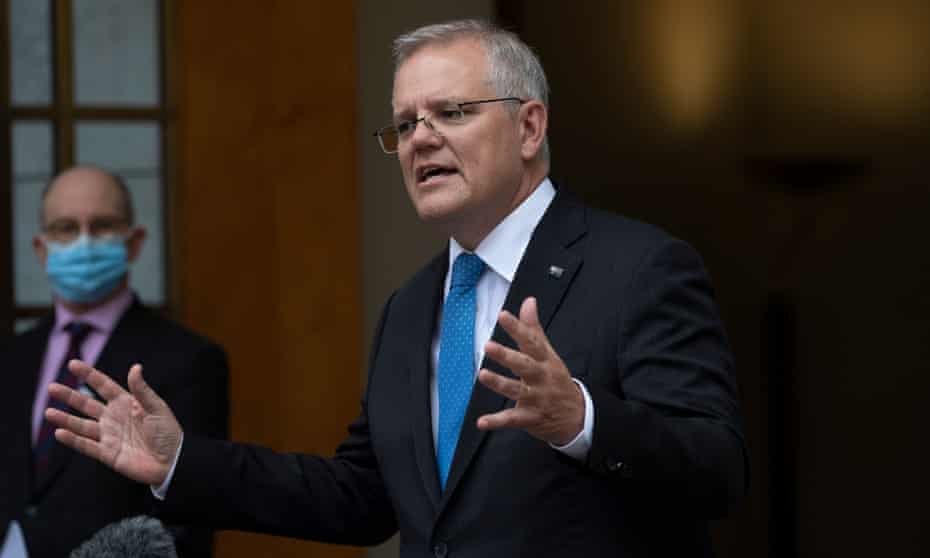Scott Morrison’s nerves showed as he squibbed net zero target and staged a climate farce

The PM should be taking a higher 2030 emissions reduction target to Cop26. No ifs, buts or maybes. Yet he squibbed it

When Scott Morrison strode into his press conference room on Tuesday to confirm Australia would be taking a net zero emissions target to the Cop26 in Glasgow, the prime minister was running on high revs.
Possibly this was an excess of adrenalin. Big parliamentary day and all that. But he looked nervous. Morrison rarely looks nervous, so this presentation was memorable.
It’s utterly reasonable to wonder why the prime minister would be nervous, given he wasn’t about to unleash a policy revolution. The Coalition’s new roadmap for achieving net zero is, depressingly, devoid of substance.
The policy might be status quo – but in political and electoral terms, the prime minister is rolling the dice. For more than a decade, the Coalition has been telling voters Australia can safely ignore the risks of global heating – a phenomenon that may or may not be happening. The battle hymn has been all about the astronomical costs of action. The promise has been everything can stay the same.
But on Tuesday, Morrison acknowledged explicitly that Australia needed to cut emissions, and emissions reduction would be a core part of the economic management strategy for the next three decades. Let’s repeat: the shift at present is rhetorical. The Coalition currently doesn’t have the suite of policies to actually deliver what Australia will pledge to do in Glasgow.
But if you want to understand just how big a rhetorical shift this is, just imagine Tony “I know I am a bit of a weather vane on this” Abbott standing up and saying (as Morrison did on Tuesday): “The world is changing, and the world’s response to climate change is changing the world, it is changing the global economy”.
“This is real. It’s happening”.
In no universe would that have ever been said, and more heterodoxy from Morrison followed. The prime minister said Australia could cut emissions and also grow the economy. For anyone with any basic grasp of these issues, this insight is about as profound as noting the sun rises in the east. It’s a statement of the obvious. But not for the Coalition.
I suspect very few people need reminding that the Coalition has won elections by claiming the opposite.
Morrison’s net zero pivot has been prompted in considerable part by the expectations of our key allies, the United States and the United Kingdom, and by the reckoning in business circles because of coordinated shareholder activism and the risk management activity of global financiers and regulators. Carbon intensity is now a bad bet, and big money never loves a bad bet.
But adopting net zero is also a concession the Coalition has lost the over-arching binary contest about climate change – whether to act or not act.
Morrison can no longer go to voters with overt or implicit climate crisis scepticism as a core pillar of his re-election strategy. The prime minister has to try something else.
It is possible that climate is now enough of an irritant in the Liberal party’s blue ribbon metropolitan heartland that Morrison will come back from Glasgow and seek to put the whole issue to bed. Having scraped off his net zero barnacle, Morrison could seek another point of high visibility contrast with Labor in the months that remain between now and the election.
But more likely, the something else Morrison will pursue is a halfway house: “our mid-century transition plan is better than Labor’s transition plan”. The lines are so rehearsed they write themselves. Labor are the serial lunatics and carbon tax merchants who will push the transition too hard in the short and medium term, because they hate farmers, and cows, and workers in traditional industries.
But, pre-Glasgow, Labor hasn’t made Morrison’s gear change easy. Right now, there’s not much concrete to rail against. As yet, there’s no settled opposition targets for 2030 or 2035, and not much clarity on the mechanisms Labor will propose to shape the transition. Morrison has had to wrestle smoke.
Because our prime minister is first, second and third a political animal – he needs “a risky counterpoint” to bounce off. That’s his sweet spot. The deep leadership element of the office – the requirement to sometimes pivot on something important, and frame a new set of national interest propositions just on their merits, not in the context of a suboptimal “other” – is not his natural territory. The pandemic gave Morrison some practice, and there were moments where he found his stride. But fundamentally, he’s a creature of the permanent campaign class.
Now don’t get me wrong. Morrison and Barnaby Joyce have worked overtime this week to conjure up the requisite risky counterpoint. As well as all the predictable ad hominem, an absurdist comedy was staged during question time where two professional legislators (the prime minister and the Nationals leader) hollered about the madness of legislators legislating things.
This high farce was staged in response to Labor suggesting that if Morrison liked net zero so much, perhaps he could legislate the target.
Apparently legislating was not the Australian way, which would be news to taxpayers who fund a representative political class to come to Canberra and make laws to govern the nation.
Despite Labor’s current lead in the polls, Anthony Albanese has been criticised for his sustained strategies of attrition and omission. As strategy goes, it’s not very inspiring.
There are obvious risks associated with dancing through raindrops. In anxious times, voters have a tendency to stick with leaders they know rather than risk unknown alternatives, and attrition and omission isn’t a strategy to be known. It’s a strategy to keep yourself in a contest, not a triumphant march to victory. Voters need a reason to change a government, even when they are frustrated with the incumbents.
But it has been really interesting watching Morrison try to square up against a nonexistent alternative. Interesting, but in the end, academic, because the current vacuum is only temporary. Morrison will have his counterpoint in the weeks after the Glasgow summit. Labor has some important decisions to make, and making them can’t be avoided for ever.
If the domestic political contest now orbits around 2030, let’s consider the elements. Morrison made a serious attempt to land an increase in the 2030 target as well as the net zero target during the recent climate deliberation. The Nationals told him to nick off. Liberals had hoped Morrison would get around the roadblock by promising a higher 2030 target at the next election. That “no” from the Nationals must have been emphatic, because the prime minister has ruled that out preemptively too.
The government’s latest emissions projections point to Australia overachieving on the Abbott-era 2030 target, which is a cut of between 26 and 28%. The projections say the reduction could be up to 35%. That gives Labor political cover to propose a higher medium term target than the Coalition. It will also be harder for the Business Council of Australia to brand the Labor alternative “economy wrecking” (as it did, disgracefully, in 2019) because the BCA now says a cut of between 46% and 50% on 2005 levels within the decade is pragmatic, ambitious and will drive investment.
As well as better cover, the shadow climate minister, Chris Bowen, also gave a billboard sized hint during a radio interview this week that Labor won’t repeat the critical error from 2019 of not having analysis to explain the costs and benefits of its climate policies. “We’ll be releasing a lot of evidence, a lot of support analysis to show that the world’s climate emergency is Australia’s jobs opportunity,” he said.
So much for politics.
Most importantly, the climate science is clear. The world needs to take significant action in this decade to address the existential risks associated with runaway global heating. Morrison should be taking a higher 2030 target, and the policies to deliver that, to Glasgow next week. No ifs, buts or maybes. But he squibbed it.
To keep faith with being a political movement of climate action, Labor needs to produce a medium term target commensurate with the scale of the threat.
Not because it’s easy, but because it’s right.
